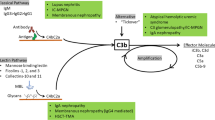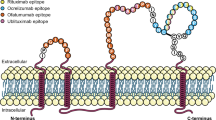Abstract
Myelin oligodendrocyte glycoprotein (MOG) is one of the autoantigens used in evaluation of the CD4+ T cells proliferation response in multiple sclerotic patients. In cell culture, human serum (HS) is one of the promising substitutions for fetal calf serum (FCS) that can induce different autoreactivity of T cells and fluctuation of autoantibody production from B cells. Because of immunomodulatory function of vitamin A, we examined the effect of HS and FCS on CD4+ T cells proliferation in response to MOG in correlation with serum retinol-binding protein (RBP)/transthyretin (TTR) ratio, as an indirect way to assess vitamin A status in multiple sclerotic patients. Patients’ peripheral blood mononuclear cells were isolated and cultured in the presence of MOG as well as FCS and HS both separately and together. Cell proliferation was evaluated using BrdU kit. Serum RBP and TTR levels were measured by ELISA kit. FCS and HS increase CD4+ T cell proliferation. RBP/TTR ratio has significant negative correlation with cell proliferation in the presence of MOG, HS, and FCS. HS with FCS provides an appropriate medium for autoreactivity and proliferation of CD4+ T cells. Vitamin A has a crucial role in regulation of this pathway.
Similar content being viewed by others
References
Ahmad SM, Haskell MJ, Raqib R, Stephensen CB (2009) Vitamin A status is associated with T-cell responses in Bangladeshi men. Br J Nutr 102(6):797–802
Bischof F, Bins A, Dürr M, Zevering Y, Melms A, Kruisbeek AM (2004) A structurally available encephalitogenic epitope of myelin oligodendrocyte glycoprotein specifically induces a diversified pathogenic autoimmune response. J Immunol 173(1):600–606
Boppana S, Huang H, Ito K, Dhib-Jalbut S (2011) Immunologic aspects of multiple sclerosis. Mt Sinai J Med 78(2):207–220
Cassani B, Villablanca EJ, De Calisto J, Wang S, Mora JR (2012) Vitamin A and immune regulation: role of retinoic acid in gut-associated dendritic cell education, immune protection and tolerance. Mol Aspects 33(1):63–76
Comabella M, Khoury SJ (2012) Immunopathogenesis of multiple sclerosis. Clin Immunol 142(1):2–8
Correale J, Ysrraelit MC, Gaitán MI (2011) Vitamin D-mediated immune regulation in multiple sclerosis. J Neurol Sci 311(1–2):23–31
Chapman MS (2012) Vitamin a: history, current uses, and controversies. Semin Cutan Med Surg 31(1):11–16
Choi J, Chung JH, Kwon GY, Kim KW, Kim S, Chang H (2013) Effectiveness of autologous serum as an alternative to fetal bovine serum in adipose-derived stem cell engineering. Cell Tissue Bank. doi:10.1007/s10561-012-9341-1
Demarest Litchford M (2012) Clinical: biochemical assessment. In: Mahan LK, Escott-Stump S, Rymond J (eds) Kruases food and the nutrition care process, 13th edn. Elsevier, St Louis, MO, pp 198–199
Fialová L, Bartos A, Soukupová J, Svarcová J, Ridzon P, Malbohan I (2009) Synergy of serum and cerebrospinal fluid antibodies against axonal cytoskeletal proteins in patients with different neurological diseases. Folia Biol (Praha) 55(1):23–26
Hamilton MJ, Banáth JP, Lam V, Lepard NE, Krystal G, Bennewith KL (2012) Serum inhibits the immunosuppressive function of myeloid-derived suppressor cells isolated from 4T1 tumor-bearing mice. Cancer Immunol Immunother 61(5):643–654
Heidt S, Roelen DL, Eijsink C et al (2010) Calcineurin inhibitors affect B cell antibody responses indirectly by interfering with T cell help. Clin Exp Immunol 159(2):199–207
Iwata M, Eshima Y, Kagechika H, Miyaura H (2004) The endocrine disruptorsnonylphenol and octylphenol exert direct effects on T cells to suppress Th1 development and enhance Th2 development. Immunol Lett 94(1–2):135–139
Jafarirad S, Siassi F, Harirchian MH et al (2012) The effect of vitamin A supplementation on stimulated T-cell proliferation with myelin oligodendrocyte glycoprotein in patients with multiple sclerosis. J Neurosci Rural Pract 3(3):294–298
Kimball S, Vieth R, Dosch HM et al (2011) Cholecalciferol plus calcium suppresses abnormal PBMC reactivity in patients with multiple sclerosis. J Clin Endocrinol Metab 96(9):2826–2834
Kuznetsov SA, Mankani MH, Robey PG (2000) Effect of serum on human bone marrow stromal cells: ex vivo expansion and in vivo bone formation. Transplantation 70(12):1780–1787
Lalive PH, Molnarfi N, Benkhoucha M, Weber MS, Santiago-Raber ML (2011) Antibody response in MOG (35–55) induced EAE. J Neuroimmunol 240–241:28–33
Lisak RP, Benjamins JA, Nedelkoska L et al (2012) Secretory products of multiple sclerosis B cells are cytotoxic to oligodendroglia in vitro. J Neuroimmunol 246(1–2):85–95
Mayer MC, Meinl E (2012) Glycoproteins as targets of autoantibodies in CNS inflammation: MOG and more. Ther Adv Neurol Disord 5(3):147–159
Mottaghi A, Salehi E, Sezavar H et al (2012) The in vitro effect of oxidized LDL and PHA on proliferation and gene expression of regulatory T cells in patients with atherosclerosis. Iran J Allergy Asthma Immunol 11(3):217–223
Parés X, Farrés J, Kedishvili N, Duester G (2008) Medium- and short-chain dehydrogenase/reductase gene and protein families: Medium-chain and short-chain dehydrogenases/reductases in retinoid metabolism. Cell Mol Life Sci 65(24):3936–3949
Pino-Lagos K, Benson MJ, Noelle RJ (2008) Retinoic acid in the immune system. Ann N Y Acad Sci 1143:170–187
Rasooly R, Schuster GU, Gregg JP, Xiao JH, Chandraratna RA, Stephensen CB (2005) Retinoid X receptor agonists increase bcl2a1 expression and decrease apoptosis of naive T lymphocytes. J Immunol 175(12):7916–7929
Rosales FJ, Ross AC (1998) A low molar ratio of retinol binding protein to transthyretin indicates vitamin A deficiency during inflammation: studies in rats and a posterior analysis of vitamin A-supplemented children with measles. J Nutr 128(10):1681–1687
Smith SM, Hayes CE (1987) Contrasting impairments in IgM and IgG responses of vitamin A-deficient mice. Proc Natl Acad Sci U S A 84(16):5878–5882
Stephensen CB, Rasooly R, Jiang X et al (2002) Vitamin A enhances in vitro Th2 development via retinoid X receptor pathway. J Immunol 168(9):4495–4503
Shingwekar AG, Mohanram M, Reddy V (1979) Effect of zinc supplementation on plasma levels of vitamin A and retinol-binding protein in malnourished children. Clin Chim Acta 93(1):97–100
Tanumihardjo SA (2011) Vitamin A: biomarkers of nutrition for development. Am J Clin Nutr 94(2):658–665
Toubi E, Nussbaum S, Staun-Ram E et al (2012) Laquinimod modulates B cells and their regulatory effects on T cells in multiple sclerosis. J Neuroimmunol 251(1–2):45–54
van der Valk J, Brunner D, De Smet K et al (2010) Optimization of chemically defined cell culture media-replacing fetal bovine serum in mammalian in vitro methods. Toxicol In Vitro 24(4):1053–1063
Wieringa FT, Dijkhuizen MA, West CE et al (2004) Reduced production of immunoregulatory cytokines in vitamin A- and zinc-deficient Indonesian infants. Eur J Clin Nutr 58:1498–1504
Wolf G (2008) Retinoic acid as cause of cell proliferation or cell growth inhibition depending on activation of one of two different nuclear receptors. Nutr Rev 66(1):55–59
Xu Y, Zhang Y, Liu CY et al (2012) Serum antibodies to 25 myelin oligodendrocyte glycoprotein epitopes in multiple sclerosis and neuromyelitisoptica: clinical value for diagnosis and disease activity. Chin Med J (Engl) 125(18):3207–3210
Zago LB, Dupraz H, Sarchi MI, Río ME (2002) The molar ratio of retinol-binding protein to transthyretin in the assessment of vitamin A status in adults. Proposal of a cut-off point. Clin Chem Lab Med 40(12):1301–1307
Ziouzenkova O, Plutzky J (2008) Retinoid metabolism and nuclear receptor responses: new insights into coordinated regulation of the PPAR–RXR complex. FEBS Lett 582(1):32–38
Author information
Authors and Affiliations
Corresponding author
Rights and permissions
About this article
Cite this article
Honarvar, N.M., Harrirchian, M.H., koohdani, F. et al. In Vitro Effect of Human Serum and Fetal Calf Serum on CD4+ T Cells Proliferation in Response to Myelin Oligodendrocyte Glycoprotein (MOG) in Correlation with RBP/TTR Ratio in Multiple Sclerotic Patients. J Mol Neurosci 50, 571–576 (2013). https://doi.org/10.1007/s12031-013-9999-2
Received:
Accepted:
Published:
Issue Date:
DOI: https://doi.org/10.1007/s12031-013-9999-2




